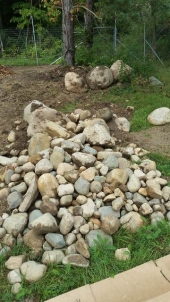posted 7 years ago
Most true cranberries (Vaccinium macrocarpon, Vaccinium oxycoccus) need very wet acidic conditions, they naturally grow in bogs and muskegs. They can tolerate some drying out but need damp most of the time. They also have really shallow root systems (pretty much within an inch or two of the surface). They are highly associated with sphagnum and while they may grow in soil they don't do very well or produce well unless in peat soil (possibly due to a dependence on mycorrhizal fungi symbiotic relationships) Straight peat or a peat/sand mix is best if you don't happen to have a peat bog in your garden. Then you want to plant in a low wet spot or create a depression, line with something (such as a pond liner) so that the area holds water and then layer on your peat and or sand. I know all this because I live in are area full of muskeg (a type of peat marsh) and have built some native garden areas that include our native bog cranberry (V. oxycoccus). I also spend a lot of time harvesting the wild ones and pay attention to where/how they grow.
In a hugelkulter bed the surface of the soil tends to be high and dry. People often have problems with seedlings because their roots haven't grown down into the center where the rotting logs and moisture is. Cranberry roots will never get that deep and so will always be in the dry soil. My guess is if you try to plant some here they'll be dead within days. They also don't transplant well so you have to baby them and keep them really wet and protected for the first season until the roots recover and the plant sends out runners. I'm just not seeing how that would work on a hugelkultur. Now having said that my experience is with the native berries. The cultivated varieties may be a bit hardier.
Lingonberry, (Vaccinium vitis-idaea) also called Low Bush Cranberry could be a candidate for you if you are willing to make some adaptations. They tolerate dryer conditions (although they still need a large amount of watering and prefer moist conditions. They actually grow really well on rotting logs. Really old, really rotten wood that you can break apart by hand is perfect for them. I have quite a few of these growing around my yard in/on rotted logs. They are also more likely to be found on soil (rather than growing in peat). I even find them growing on rock piles and in gravel edges of old logging roads here. But as I live in a rain forest even the rock piles are wet. I've actually created some small low hugelbeds for my lingonberries. I took some old, rotting logs and half buried them. I laid them out side by side with a small gap between them. This gap was filled with a mix of acidic soil and peat. The lingonberries were then nestled into the low areas where their rootscould grow down into the soil in the gaps and the runners could spread out over the tops of the logs. I covered the rest of the exposed logs with moss (as I have an unlimited supply) to help the logs retain moisture. You could go ahead and cover logs with a very thin layer of soil and then mulch really well. I think that would serve the same function to retain moisture in the logs.
So if you have already built the more traditional mounded hugelbeds I don't think you'll be able to plant any type of cranberry. You might get away with the lingonberries along the lower edges where they can stay wetter and roots might be able to access the buried wood.








